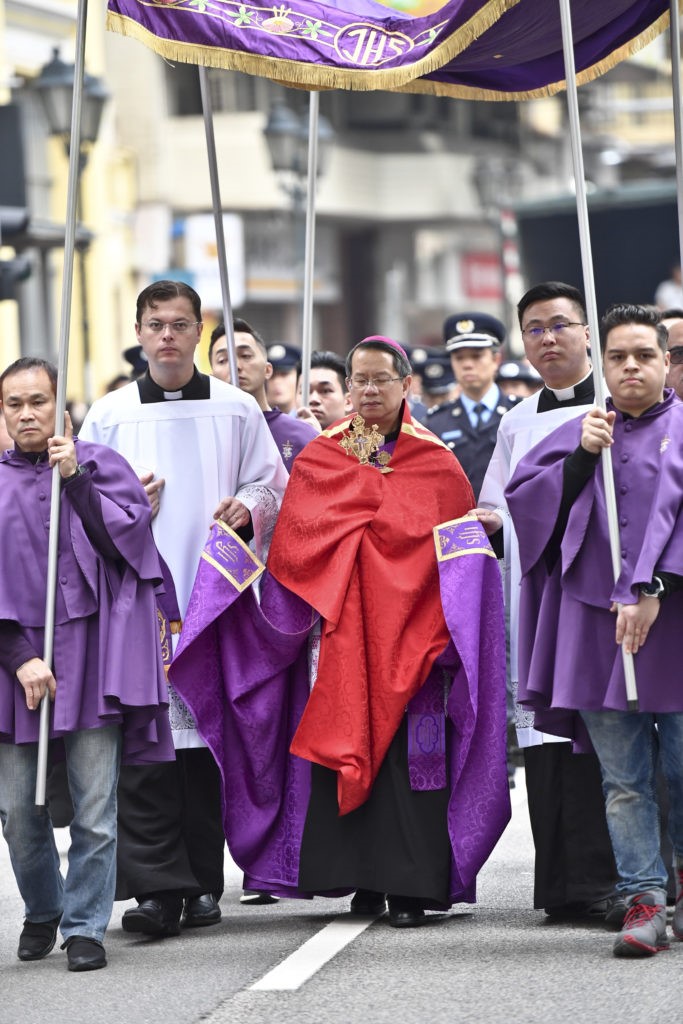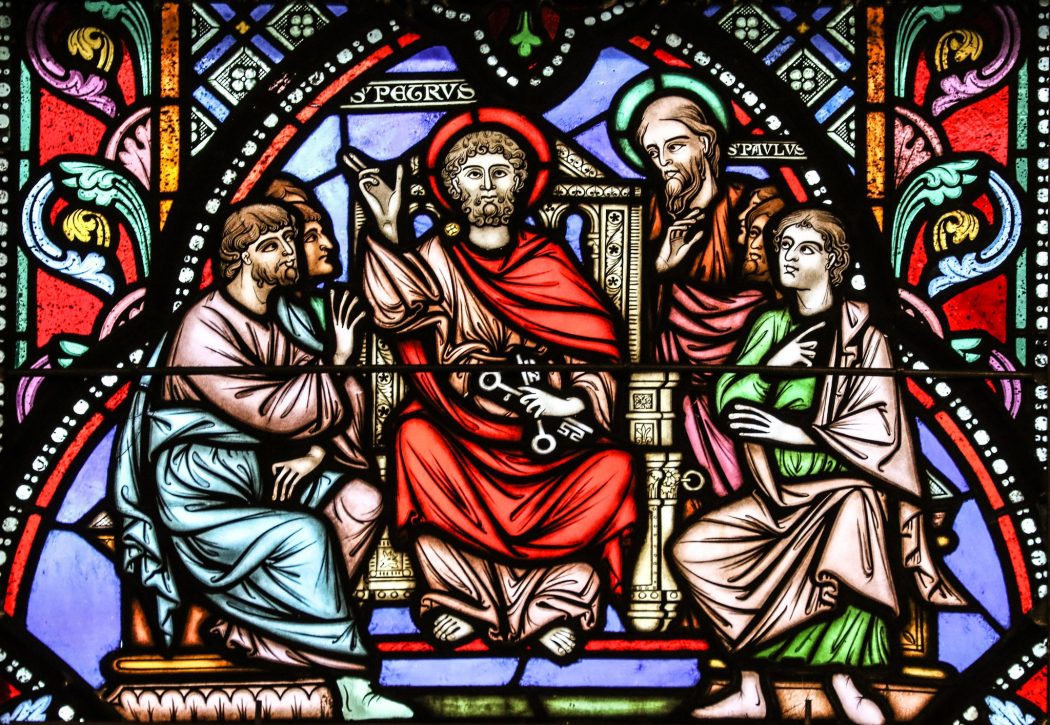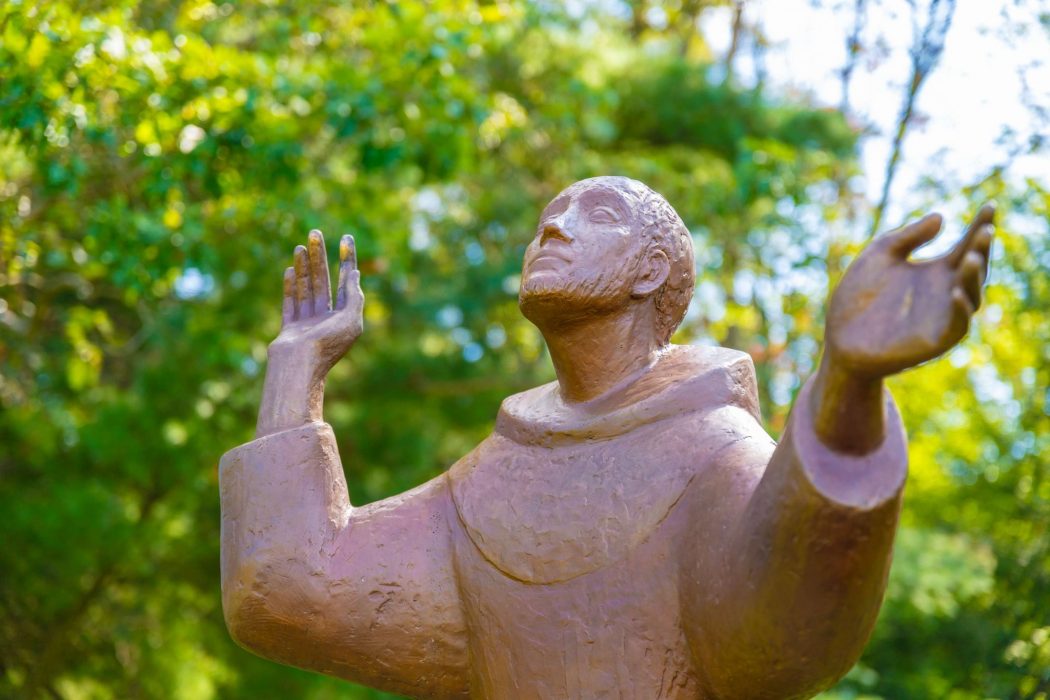Bishop Stephen Lee carries the Lignum Crucis contained in a reliquary during the procession of Our Lord Bom Jesus dos Passos on March 10.
– Miguel Augusto (*)
The Cross on which Our Lord was crucified became one of the most famous relics in all of Christendom. The True Cross is the greatest and most precious of all relics. It is only before the True Cross, from among all other relics, that the Christian faithful are instructed to genuflect. Every other image and relic – whether of our Lord or any of the saints – is venerated by a bow, but the relic of the True Cross is adored and worshipped with a genuflection. A fragment of the Holy Cross – the “Lignum Crucis,” was brought during the Procession of Our Lord Bom Jesus dos Passos on 10th of March by our bishop D. Stephen Lee. We take the opportunity to pause before this relic, not well known by the faithful and consequently not so revered.
Those who attend the procession could note closely when the bishop brought the reliquary during the procession; there are two noteworthy details: (1) the canopy; and (2) the humeral veil that Bishop Lee used to carry the Relic of the Wooden Cross and placed over the pluvial cope that he wore. These two things – canopy and humeral veil – are usually used only during a procession with the Blessed Sacrament, although in the case of the Blessed Sacrament, the pluvial cope and the humeral veil are white or golden. Hence, the veneration due to the Holy Cross is close to that of the Eucharist.
Moreover, at the end of the procession, the Bishop gave the Blessing with the Relic of the True Cross, just as he gives the Blessing or Benediction with the Blessed Sacrament.
The relic (fragment) of the Holy Cross in Macau, can be visited and venerated at the church of Sé Cathedral. It is located on an altar on the right side of the church’s central nave, where the choir usually sings.
The finding of the Holy Cross
Through divine inspiration, Empress Helena joined Christ’s faithful, alongside her son, the Roman Emperor Constantine I (who legalized Christianity in 312 AD), and at the age of 80, went off in search of the most sought-after relic: The Cross of Jesus.
At Golgotha, the cross was thrown into a hole in the ground, along with those the two thieves were crucified on. Arriving at the Holy Land 300 years later, Helena ended up finding the three crosses, but which one belonged to the Lord? To find out, the bishop of Jerusalem had an idea: he asked a woman, who suffered from a sickness considered incurable, to touch the wood, and upon touching one of the three crosses she was healed straight away. Helena had no doubt at all: she found Jesus’ cross immediately and promptly ordered the building of a church where it was discovered – which she called the Church of the Resurrection – and she then set off for Rome.
Saint Ambrose (339-397 AD) offers us a glimpse of Constantine’s mother in ancient Jerusalem: “The Holy Spirit inspired her to seek the wood of the Cross. She approached Golgotha and said: ‘This is the place of combat: where is Your victory?’”
St Cyril of Jerusalem (386 AD) first discussed its veneration in his catechetical sermons (348-350 AD).
The Cross as the image of Christ
Additionally, the Cross deserves special veneration and worship on account of the fact that it is uniquely an image of Christ. Indeed, even more than images made after the proper proportions of his natural body – i.e. paintings, icons, and sculptures made after the physical likeness of Christ – the Cross is THE image of our Savior. More even than the image of The Divine Mercy, the True Cross represents Christ as His perfect icon.
The Scriptures themselves testify, according to the interpretation of the Church Fathers and Doctors, that the Cross is the “Sign of the Son of Man” (Matthew 24:30). Moreover, Christ is identified as “the one who was crucified” – though many events occurred throughout our Savior’s life, it is the crucifixion which really defines who He is for us. Therefore, more than any other image, it is the Cross which represents the Person of our Savior.
Therefore, it is worthy of a higher veneration and even of worship, over and above every other relic or icon. The True Cross is the only relic which is given a special feast in the calendar of the Roman Liturgy. September 14th, is the “Feast of the Exaltation of the Cross”.
St Thomas Aquinas affirms that the Church does indeed worship the True Cross since we put our hope of salvation in the wood of the Cross. However, St Thomas affirms that worship is due, in the first place, to God alone – i.e. we worship only the Divine Essence (The Most Blessed Trinity) for its own sake.
But the Cross was most highly and perfectly united to the Person of Jesus in the plan of salvation – for it was through the wood of the Cross that our Savior redeemed us. Moreover, this wood has been saturated with the most precious and holy Blood of our Lord. This same wood has borne the limbs of Christ and was sanctified by contact with his Body.
This special and unique role of the Cross is proclaimed by the Church when she says: “We worship you O Christ and we bless you, for by your holy Cross you have redeemed the world” – Holy Mother Church does not speak about any other relic in this manner.
Sacred Scripture tells the story of Simon of Cyrene, the man who was compelled to carry the Cross of Jesus during the Passion. Although we know nothing more about his life, the Gospel of Mark records that his sons, Simon and Rufus, became missionaries and leading figures in the Christian community in Rome. Simon’s act of compassion has been immortalized in the fifth station of the Way of the Cross.
A Cross to the world
Hidden many times and then rediscovered, chopped into pieces and dispersed, the precious relic has taken many journeys.
The largest fragment of the Holy Cross is preserved in Greece in the monastery of Mount Athos; other significant fragments are in Rome, Brussels, Venice, Ghent, and Paris.
Pope Benedict XVI has said: “Are we able to understand that in the Crucified One of Golgotha, our dignity as children of God, tarnished by sin, is restored to us? Let us turn our gaze towards Christ. It is He who will make us free to love as He loves us, and to build a reconciled world. For on this Cross, Jesus took upon himself the weight of all the sufferings and injustices of our humanity. He bore the humiliation and the discrimination, the torture suffered in many parts of the world by so many of our brothers and sisters for love of Christ.”
We know that many churches in Europe are treasure troves of ancient relics. But not many can rival the extensive collection of the ancient Basilica of the Holy Cross in Jerusalem, built during the 4th century in Rome. Located in the Equilino neighbourhood, home to many of Rome’s ethnic communities, the Basilica of the Holy Cross in Jerusalem (Santa Croce in Gerusalemme) owes its name to the most precious of the relics it hosts: fragments of the Holy Cross found on the exact location where Jesus was crucified. The church name comes from the Jerusalem soil that was laid on the floor of the basilica, as a way of moving part of the Holy city to Rome.
Jesus told us that whoever wants to follow Him must bear his cross (Luke 9:23), and the Gospel points to us in the person of Simon of Cyrene. But the cross is not only suffering, it speaks to us in many ways and requires from us to meditate on it, for in the cross of Christ, in its essence we see the love of God for us. There Jesus speaks to us: “Look at me, here on the cross and see that I gave you everything until my last breath. I am the good shepherd. The good shepherd lays down his life for the sheep. No one takes it from me, but I freely offer it. I suffered your pains, your disappointments, your despair, your loneliness… I paid for your sins and gave my life so that you may have life and have it in abundance. In the world you will have trouble, but take courage, I have conquered the world.”
When we trace the sign of the cross on our bodies, we unite with our brothers in Christ, who with the same sign, join us to form an invisible chain which binds us to Our Lord.
May the Cross of Jesus be ever engraved in our hearts.


 Follow
Follow


